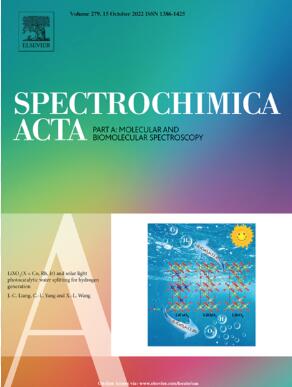An acylaminoacyl-peptide hydrolase-activated fluorescent probe for ultrasensitive detection of pesticide residue
IF 4.3
2区 化学
Q1 SPECTROSCOPY
Spectrochimica Acta Part A: Molecular and Biomolecular Spectroscopy
Pub Date : 2025-04-03
DOI:10.1016/j.saa.2025.126152
引用次数: 0
Abstract
Due to increasing threats to global public health and widespread environmental pollution issues caused by improper and excessive application of pesticides, the detection of pesticide residues is important in securing food safety and responding to public health. However, conventional methods for pesticide residues detection were usually labor- and time-consuming, making the acquisition of efficient tools for rapid and sensitive detection of pesticide residues an urgent need. Enzyme-targeted organic fluorescent probes, which displayed high simplicity and sensitivity, have shown great potential in enzyme inhibition-based pesticide residues detection and related bioimaging. Among these, fluorescent probes-based biosensors for pesticide targeted serine hydrolyses such as carboxylesterases and cholinesterases have been widely developed.
Acylaminoacyl-peptidase hydrolase (APEH), a serine hydrolase with typical α/β fold structure, is a promising protein target for pesticides such as organophosphorus (OPs) and carbamate. However, no fluorescent probe targeting APEH has been reported for pesticide detection or related research. To address this, an enzyme-activated fluorescent probe (named as RH-AcA) with high sensitivity (limit of detection = 3.7 mU/mL), binding affinity (Km = 6.49 ± 0.29 μM) and high specificity toward APEH was constructed whilst inhibitory efficacy of different pesticides toward APEH in living cells and zebrafish was first visualized. Most importantly, APEH-inhibition-based pesticide residues detection was first achieved using RH-AcA, revealing significantly higher detection sensitivity toward OPs compared to esterase-based fluorescent probes This demonstrated APEH is a promising non-esterase target for enzyme-inhibition-based pesticide residues detection, and RH-AcA could serve as an ultrasensitive and practical tool for pesticides detection and related bioimaging.

由于不当和过量施用农药对全球公众健康的威胁日益严重,环境污染问题普遍存在,农药残留检测对于保障食品安全和应对公众健康问题十分重要。然而,传统的农药残留检测方法通常耗费大量人力和时间,因此迫切需要获得快速、灵敏检测农药残留的高效工具。酶靶向有机荧光探针具有高简易性和高灵敏度,在基于酶抑制的农药残留检测和相关生物成像方面显示出巨大潜力。Acylaminoacyl-peptidase hydrolase(APEH)是一种丝氨酸水解酶,具有典型的α/β折叠结构,是有机磷(OP)和氨基甲酸酯等农药的有望靶标蛋白。然而,目前还没有针对 APEH 的荧光探针用于农药检测或相关研究的报道。为了解决这个问题,我们构建了一种酶活化荧光探针(命名为 RH-AcA),它具有高灵敏度(检测限 = 3.7 mU/mL)、与 APEH 的结合亲和力(Km = 6.49 ± 0.29 μM)和高特异性,并首次在活细胞和斑马鱼中观察了不同农药对 APEH 的抑制作用。最重要的是,利用 RH-AcA 首次实现了基于 APEH 抑制的农药残留检测,发现与基于酯酶的荧光探针相比,RH-AcA 对 OPs 的检测灵敏度显著提高,这表明 APEH 是一种有望用于基于酶抑制的农药残留检测的非酯酶靶标,RH-AcA 可作为一种超灵敏的实用工具,用于农药检测和相关的生物成像。
本文章由计算机程序翻译,如有差异,请以英文原文为准。
求助全文
约1分钟内获得全文
求助全文
来源期刊
CiteScore
8.40
自引率
11.40%
发文量
1364
审稿时长
40 days
期刊介绍:
Spectrochimica Acta, Part A: Molecular and Biomolecular Spectroscopy (SAA) is an interdisciplinary journal which spans from basic to applied aspects of optical spectroscopy in chemistry, medicine, biology, and materials science.
The journal publishes original scientific papers that feature high-quality spectroscopic data and analysis. From the broad range of optical spectroscopies, the emphasis is on electronic, vibrational or rotational spectra of molecules, rather than on spectroscopy based on magnetic moments.
Criteria for publication in SAA are novelty, uniqueness, and outstanding quality. Routine applications of spectroscopic techniques and computational methods are not appropriate.
Topics of particular interest of Spectrochimica Acta Part A include, but are not limited to:
Spectroscopy and dynamics of bioanalytical, biomedical, environmental, and atmospheric sciences,
Novel experimental techniques or instrumentation for molecular spectroscopy,
Novel theoretical and computational methods,
Novel applications in photochemistry and photobiology,
Novel interpretational approaches as well as advances in data analysis based on electronic or vibrational spectroscopy.

 求助内容:
求助内容: 应助结果提醒方式:
应助结果提醒方式:


